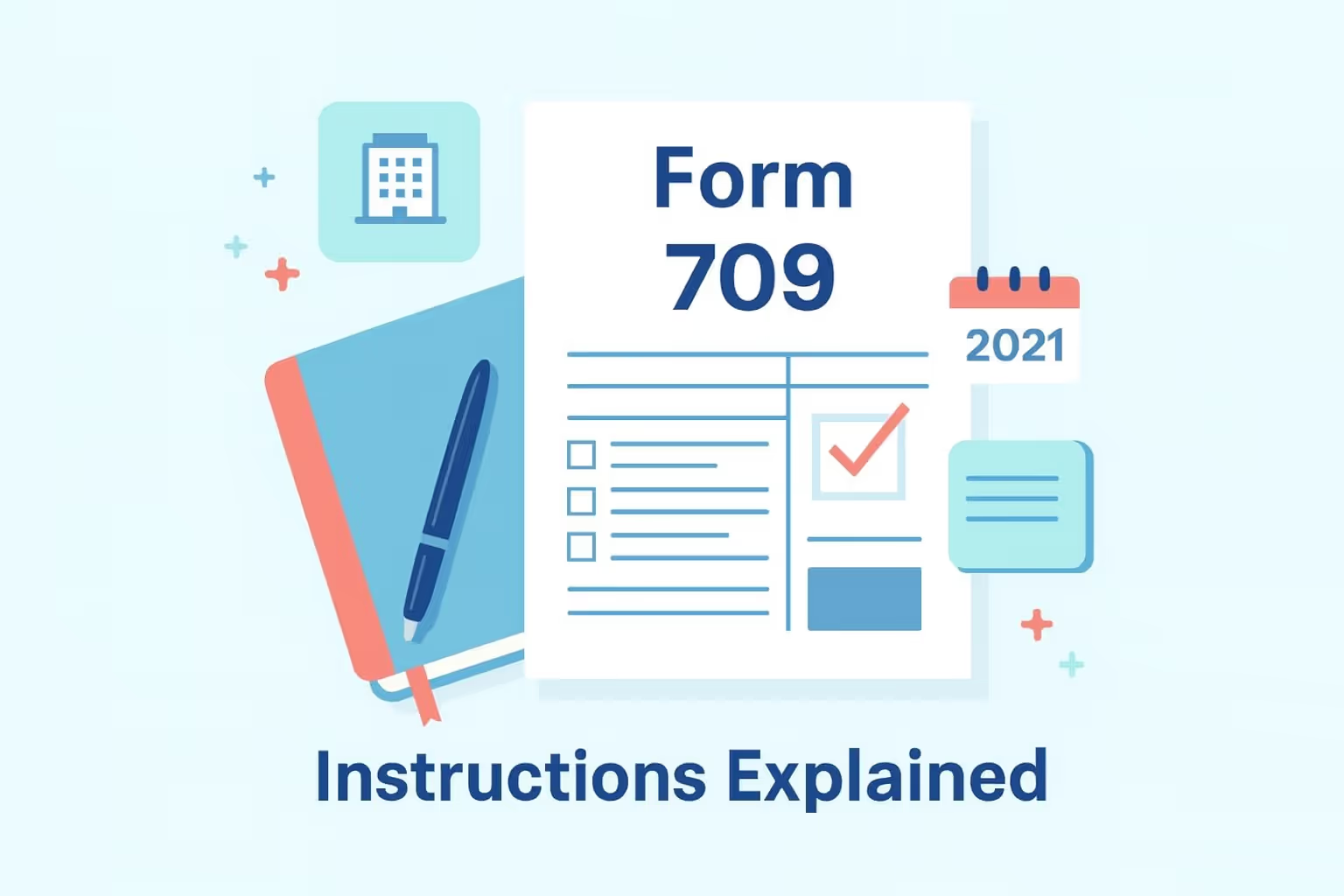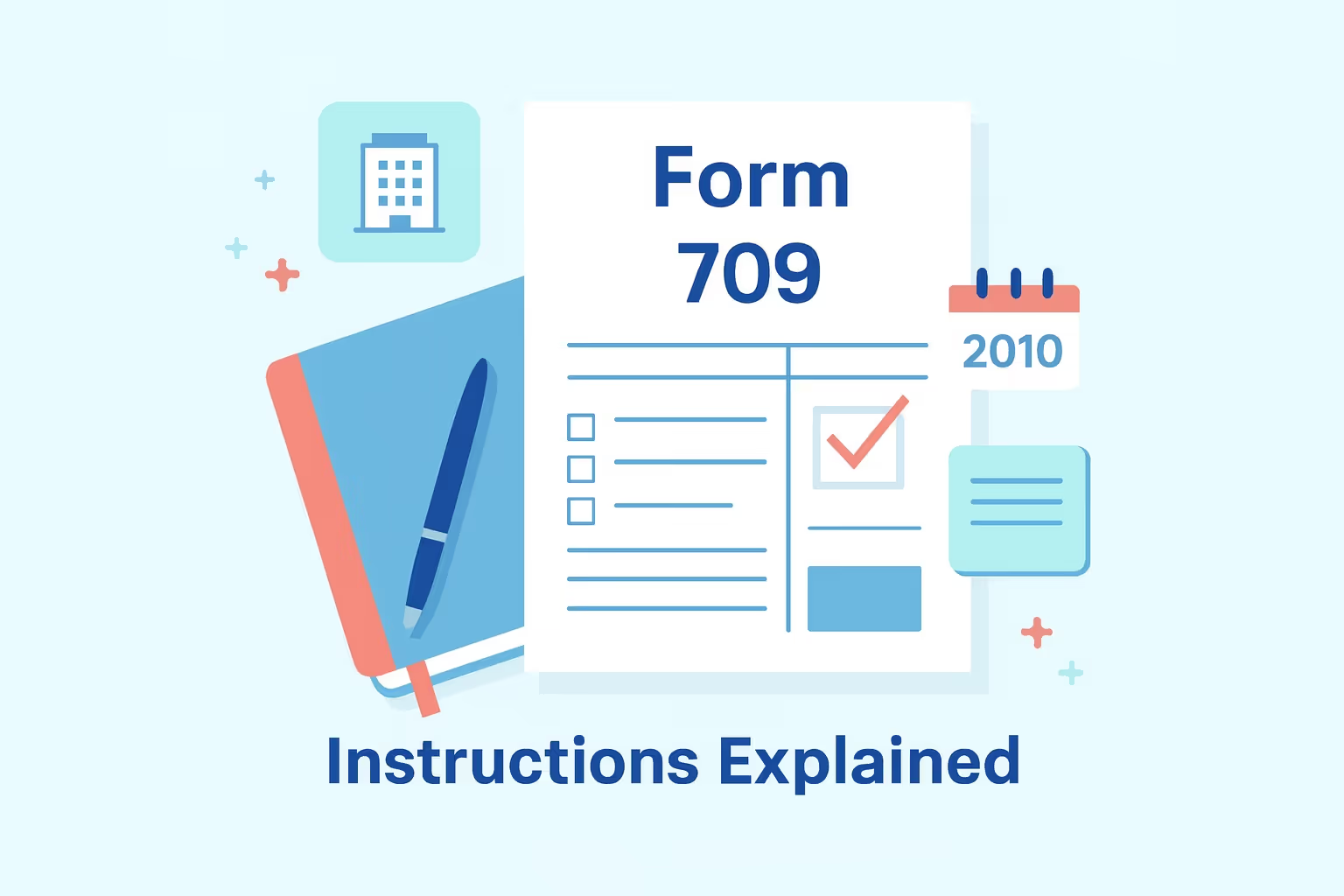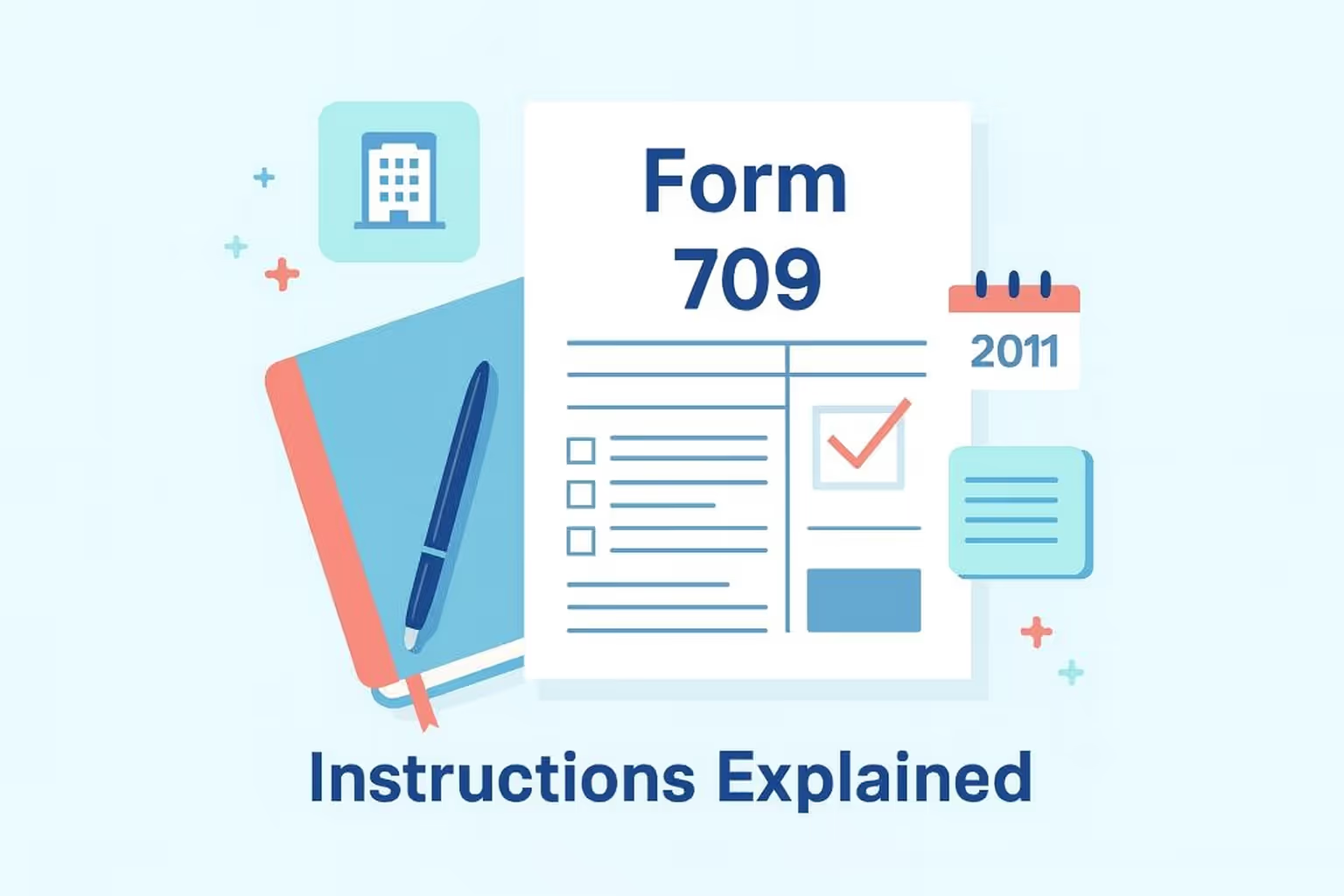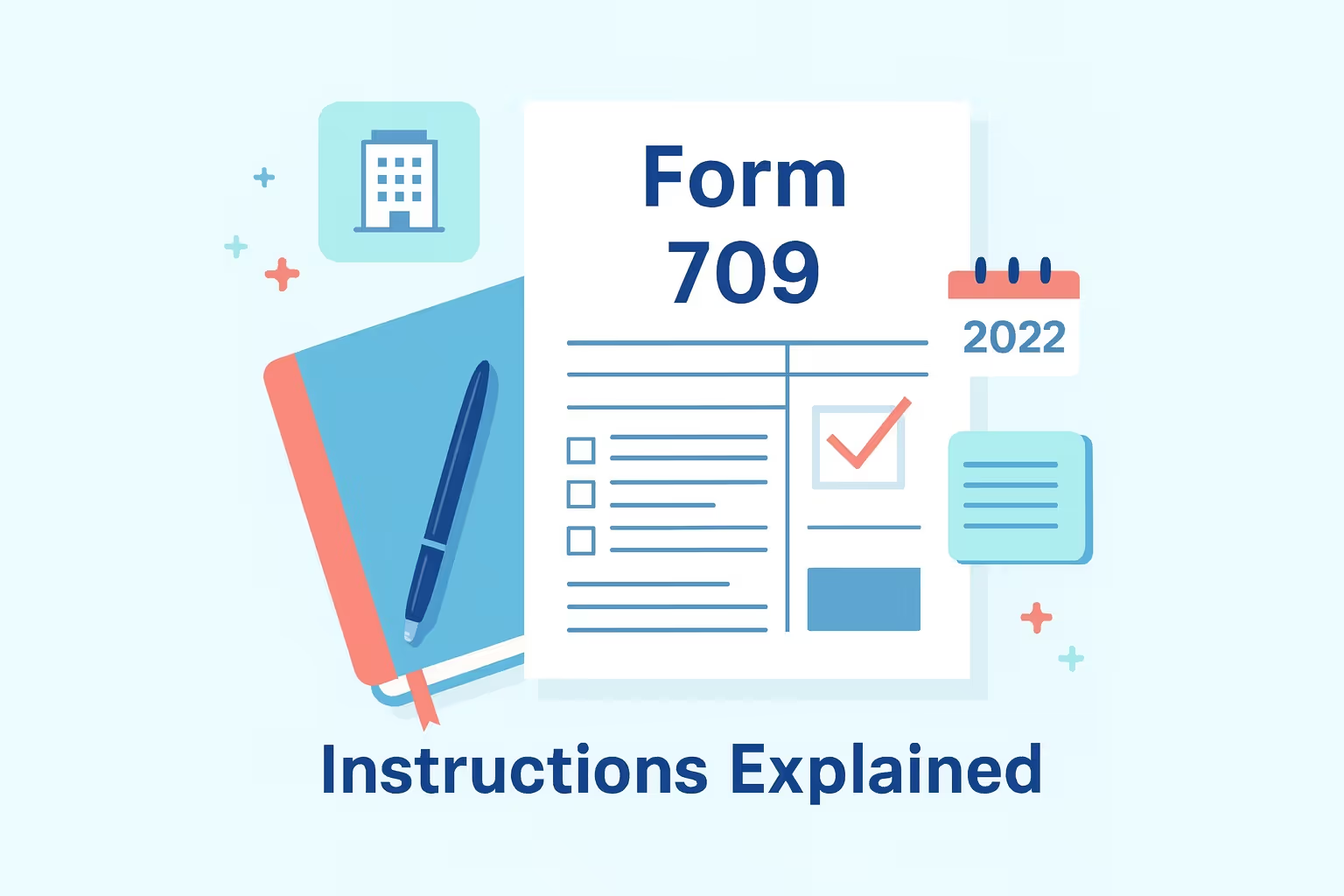Instrucciones del formulario 709 2021: Guía para la declaración de impuestos sobre donaciones

El formulario 709, oficialmente denominado Declaración de impuestos sobre donaciones (y transferencias generacionales) de los Estados Unidos, informa sobre ciertas donaciones realizadas durante el año tributario. Es posible que tengas que presentar este formulario federal si le has regalado a alguien propiedades, dinero u otros activos que superen el límite anual de exclusión del impuesto sobre donaciones. Para el año tributario 2021, la exclusión anual fue de 15 000$ por destinatario, y la exención fiscal vitalicia sobre donaciones fue de 11,7 millones de $. Estos límites ayudan a determinar si alguna parte de sus donaciones está sujeta al impuesto federal sobre donaciones o si se tiene en cuenta para su exención del impuesto sobre el patrimonio.
El Servicio de Impuestos Internos (IRS) exige que las personas presenten el formulario 709 cuando las donaciones superen la exclusión anual o impliquen transferencias especiales, como la división de obsequios entre cónyuges o las transferencias generacionales a nietos. Si bien la mayoría de las personas no adeudan impuestos sobre donaciones debido a la elevada exención de por vida, es esencial presentar informes precisos. La presentación del formulario garantiza que se haga un seguimiento adecuado de todas las donaciones sujetas a impuestos y que el monto total de la exclusión se actualice para los próximos años. También lo protege de multas o disputas relacionadas con transferencias infravaloradas o no declaradas.
Esta guía de instrucciones del formulario 709 2021 lo guía a través de cada paso del proceso, desde determinar quién debe presentar la solicitud hasta completar los cronogramas, enviar su declaración por correo y evitar errores comunes. Ya sea que presente su declaración por primera vez o esté ayudando a alguien a declarar el impuesto sobre donaciones, este artículo proporciona explicaciones claras y fáciles de seguir que le ayudarán a cumplir con las normas y tener confianza al presentar su declaración de impuestos sobre donaciones.
¿Qué es el formulario 709 y quién debe presentarlo?
El formulario 709, oficialmente denominado Declaración de impuestos sobre donaciones (y transferencias generacionales) de los Estados Unidos, declara las donaciones que superan la exclusión fiscal anual sobre donaciones o implica transferencias especiales, como las donaciones a nietos. El Servicio de Impuestos Internos (IRS) utiliza este formulario para registrar las donaciones sujetas a impuestos, calcular la responsabilidad potencial y hacer un seguimiento de la exención fiscal sobre donaciones que le queda de por vida.
El formulario 709 también documenta las donaciones que pueden afectar más adelante su exención del impuesto sobre el patrimonio. Le da al IRS un registro claro de sus transferencias acumuladas a lo largo de su vida. El formulario se usa para reportar varios tipos de transacciones:
- Regalos que superan el monto de exclusión anual: Cualquier donación de más de 15 000$ hecha a un solo destinatario en 2021 debe declararse, incluso si no se adeuda ningún impuesto.
- Transferencias generacionales (GST): Se trata de regalos hechos directa o indirectamente a nietos u otras personas que están más de una generación por debajo de usted.
- Elecciones para repartir regalos: Las parejas casadas pueden optar por dividir los obsequios, lo que les permite donar conjuntamente hasta 30 000 dólares por destinatario sin superar el límite de exclusión.
- Asignaciones de la exención vitalicia: El IRS usa esta información para determinar cuándo un contribuyente alcanza la exención vitalicia de 11.7 millones de dólares para 2021.
La presentación del formulario 709 proporciona un registro transparente de las transferencias declarables y garantiza el cumplimiento de los requisitos del impuesto federal sobre donaciones y el impuesto sobre sucesiones. También ayuda a los contribuyentes a gestionar su planificación de exenciones a largo plazo y a evitar multas.
Requisitos de presentación
Cualquier ciudadano o residente de los EE. UU. debe presentar el formulario 709 para el año tributario 2021 si se cumple alguna de las siguientes condiciones:
- Los obsequios que superaban los 15 000 dólares se entregaron a una persona que no era un cónyuge ciudadano estadounidense.
- Se realizaron transferencias con intereses futuros, en las que el derecho del destinatario a usar o beneficiarse de la donación comienza más adelante.
- Se tomó la decisión de dividir una donación entre los cónyuges, incluso cuando cada porción permanecía por debajo del umbral de exclusión anual.
- Durante el año, se transfirieron más de 159 000 dólares en activos o fondos a un cónyuge no ciudadano.
- La propiedad comunitaria se dividió o distribuyó, lo que obligó a cada cónyuge a presentar una declaración por separado por su parte respectiva.
- Se produjo una transferencia generacional, como una donación directa a los nietos o contribuciones a un fideicomiso que benefició a generaciones posteriores.
Transferencias no sujetas a impuestos
Ciertas transferencias no se consideran donaciones sujetas a impuestos y, por lo tanto, no es necesario presentarlas en el formulario 709. Estos tipos de obsequios cumplen con las excepciones específicas del IRS que permiten excluirlos de las normas fiscales federales sobre donaciones:
- Las donaciones a un cónyuge ciudadano estadounidense califican para la deducción matrimonial ilimitada, lo que significa que están totalmente exentas del impuesto federal sobre donaciones.
- Se excluyen los pagos realizados directamente a una institución educativa para pagar la matrícula de otra persona porque se consideran gastos educativos calificados.
- Los pagos realizados directamente a los proveedores médicos por las facturas médicas de otra persona se excluyen cuando cubren gastos médicos calificados.
- Las donaciones hechas a organizaciones caritativas o exentas calificadas reconocidas por el IRS no están sujetas al impuesto sobre donaciones porque tienen un propósito público aprobado.
- También se excluyen las donaciones hechas directamente a una organización política, siempre que la organización cumpla con la definición de entidad política del IRS.
Si todos sus obsequios de 2021 estuvieron por debajo del monto de exclusión anual y ninguno pertenece a estas categorías especiales, generalmente no necesita presentar el formulario 709. Para obtener información completa y oficial, visite la página del sitio web del IRS en Formulario 709.
Actualizaciones clave para el año tributario 2021
El Servicio de Impuestos Internos (IRS) hizo varios ajustes al Formulario 709 para el año tributario 2021. Estas actualizaciones afectaron la forma en que los contribuyentes calculan las exclusiones, los créditos y la obligación tributaria sobre donaciones. Si bien la exclusión anual del impuesto sobre donaciones se mantuvo en 15 000$ por destinatario, otros límites necesarios aumentaron ligeramente debido a los ajustes por inflación.
La exención básica del impuesto sobre donaciones y sucesiones de por vida aumentó a 11,7 millones de dólares en 2021, frente a los 11,58 millones de 2020. Este umbral más alto permitía a las personas transferir más patrimonio sin incurrir en el impuesto federal sobre donaciones. Del mismo modo, el equivalente crediticio aumentó a 4.625.800 dólares, y la exclusión de los cónyuges no ciudadanos aumentó a 159 000 dólares. La tasa impositiva máxima sobre donaciones se mantuvo sin cambios en el 40 por ciento.
Exclusión de obsequios anuales
- Monto de 2021: 15 000 dólares
- Monto de 2020: 15 000 dólares
Exclusión básica de por vida
- Monto de 2021: 11.700.000 dólares
- Monto de 2020: 11.580.000 dólares
Exclusión de cónyuges no ciudadanos
- Monto de 2021: 159.000 dólares
- Monto de 2020: 157.000 dólares
Monto de crédito básico
- Monto de 2021: 4.625.800 dólares
- Monto de 2020: 4.577.800 dólares
Tasa impositiva máxima
- Tarifa de 2021: 40%
- Tarifa 2020: 40%
Estas cifras actualizadas garantizan que los contribuyentes puedan tomar decisiones informadas sobre los informes de donaciones y las transferencias libres de impuestos. Comprender los nuevos límites ayuda a las personas a planificar las donaciones de manera estratégica y, al mismo tiempo, cumplir con las instrucciones del formulario 709 del IRS y las regulaciones federales sobre impuestos sobre donaciones.
Guía paso a paso para presentar el formulario 709
La presentación correcta del formulario 709 garantiza que su declaración de impuestos sobre donaciones cumple con las normas federales y refleja la información precisa de todas las donaciones realizadas durante el año. Los siguientes pasos resumen cómo preparar, completar y presentar su declaración de 2021.
1. Prepárese antes de archivar
Antes de completar el formulario, es esencial recopilar documentación precisa. Usted debe:
- Reúna todos los registros de los obsequios realizados en 2021, incluidas las fechas, los nombres de los destinatarios y las descripciones.
- Determine el valor justo de mercado de cada obsequio y obtenga tasaciones cuando sea necesario.
- Confirme la relación entre usted y cada destinatario.
- Revise las presentaciones anteriores del Formulario 709 y cualquier crédito vitalicio que ya haya utilizado.
- Decida si desea repartir las donaciones con su cónyuge, si corresponde.
Al completar estos pasos, se asegura de que su declaración de impuestos sobre donaciones esté completa y de que la documentación de respaldo esté lista en caso de que el IRS la revise.
2. Complete la parte 1: Información general
La parte 1 del formulario 709, que incluye las líneas 1 a 19, registra los detalles básicos del contribuyente y el estado civil civil. Cada línea debe completarse con cuidado:
- Proporcione su nombre, dirección y número de seguro social
- Indique su ciudadanía y si solicitó una extensión de presentación.
- Indique si presentó anteriormente una declaración de impuestos sobre donaciones.
- Marque la casilla para dividir los regalos, si corresponde, y asegúrese de que ambos cónyuges firmen en la línea 18.
- Ingresa la información relevante si se aplica una exclusión no utilizada (DSUE) del cónyuge fallecido.
Estas entradas sientan las bases para su regreso y confirman si las elecciones especiales se aplican a su situación.
3. Complete el Anexo A: Informe de obsequios
El Anexo A es donde se enumeran todos los obsequios entregados en 2021. Incluye cuatro partes, cada una con un propósito distinto:
- Parte 1: Regalos sujetos únicamente al impuesto sobre donaciones: En esta sección se enumeran todas las donaciones sujetas a impuestos hechas directamente a personas físicas.
- Parte 2: Saltos directos: Esta sección informa sobre los obsequios hechos a nietos u otras personas que estén más de una generación por debajo de usted.
- Parte 3 — Omisiones indirectas y transferencias en fideicomiso: Esta sección cubre las transferencias a fideicomisos que más adelante podrían estar sujetas al impuesto sobre transferencias saltadoras (GST).
- Parte: Conciliación de donaciones imponibles: Esta sección calcula el total de sus donaciones sujetas a impuestos después de aplicar las exclusiones y deducciones.
Cada entrada debe incluir el nombre, la dirección, la relación con usted y la descripción del regalo del destinatario. Indique el valor total de los obsequios divididos y especifique la parte que le corresponde a cada cónyuge.
4. Complete el Anexo B: Regalos de períodos anteriores
El Anexo B resume las donaciones sujetas a impuestos declaradas en años anteriores. Debe incluir el año de cada presentación anterior, la oficina del IRS que la procesó y cualquier crédito solicitado. Este cronograma garantiza un cálculo preciso de la exención impositiva sobre donaciones de por vida que le queda.
5. Complete el Anexo C: Exclusión no utilizada para cónyuges fallecidos (DSUE)
Si recibió un monto de DSUE de un cónyuge fallecido, el Anexo C le permite declararlo y aplicarlo a las donaciones actuales. Incluir esta cantidad correctamente ayuda a hacer un seguimiento preciso de la exención total de por vida y evita la doble contabilización.
6. Complete el Anexo D: Impuesto sobre transferencias generacionales (GST)
El Anexo D se aplica solo cuando los obsequios están sujetos al impuesto de transferencia generacional. Esto incluye las donaciones a los nietos o las transferencias a fideicomisos que se saltan una generación. Al completar este cronograma, se garantiza que se apliquen a esas transferencias las tasas de exención e inclusión adecuadas del GST.
7. Calcule el impuesto sobre donaciones en la parte 2
Después de sumar el total de sus donaciones sujetas a impuestos del Anexo A, anote el monto en la Parte 2 en las líneas 1 a 7. Usa la tabla de impuestos sobre donaciones del IRS para calcular tu impuesto provisional y, a continuación, aplica el crédito unificado disponible para determinar si queda algún saldo pendiente. Un cálculo preciso evita que se impongan multas o pagos insuficientes.
8. Revise las elecciones, las deducciones y los archivos adjuntos
Antes de firmar, confirme que todas las elecciones y deducciones estén debidamente documentadas. Si corresponde, solicite la deducción conyugal o elija una propiedad con interés rescindible calificada (QTIP). Adjunte todos los estados de cuenta, tasaciones o registros justificativos que sean necesarios para validar los valores declarados.
9. Firme, feche y envíe la declaración
Una vez que todos los cronogramas y las piezas estén completos, revise cada página para comprobar su precisión. Firme y feche la página 1 de la declaración y asegúrese de que su cónyuge también firme si usted eligió dividir los regalos. Envíe por correo el formulario 709 completado al centro de servicio del IRS correcto que aparece en las instrucciones.
Uso de las instrucciones del IRS para Formulario 709 (2021) como referencia, garantiza que cada sección se complete correctamente, que todos los valores se verifiquen y que todos los informes cumplan con las normas federales del impuesto sobre donaciones.
Instrucciones y fechas límite de presentación
Para el año tributario 2021, el formulario 709 debe presentarse en papel, ya que el IRS no ofrece una opción de presentación electrónica. Las declaraciones completadas deben enviarse por correo al Centro de Servicio de Impuestos Internos correcto según el método de entrega.
Si utiliza el correo normal, envíe su declaración a:
Departamento del Tesoro
Centro de Servicio de Impuestos Internos
Kansas City, MO 64999
Si utilizas un servicio de entrega privado, como FedEx o UPS, envíalo por correo a:
Servicio de Impuestos Internos
333 W. Pershing Road
Kansas City, MO 64108
La fecha límite para presentar el Formulario 709 de 2021 fue el 15 de abril de 2022, fecha que coincidía con la fecha límite para las declaraciones de impuestos individuales sobre la renta. Si recibió una prórroga automática para presentar su declaración de impuestos sobre la renta personal (formulario 4868) o su declaración de impuestos sobre el patrimonio (formulario 4768), esa prórroga también se aplicó a su declaración de impuestos sobre donaciones. Sin embargo, las prórrogas solo posponen la fecha de presentación; no retrasan el pago de ningún impuesto sobre donaciones adeudado.
Los contribuyentes deben firmar y fechar el formulario antes de enviarlo por correo e incluir cualquier anexo o anexo de respaldo requerido. Para confirmar la entrega puntual, se recomienda que utilicen correo certificado y soliciten un acuse de recibo. Presentarlo antes de la fecha límite correspondiente y enviarlo a la dirección correcta ayuda a evitar multas y garantiza el cumplimiento de las instrucciones del formulario 709 de 2021 del IRS y de los requisitos federales de declaración del impuesto sobre donaciones.
Pagar el impuesto sobre donaciones y evitar multas
Para fines del impuesto sobre donaciones, la mayoría de los contribuyentes no adeudarán impuestos federales inmediatos cuando presenten sus declaraciones de impuestos sobre donaciones, porque el monto de la exención de por vida protege la mayoría de las transferencias de impuestos. En 2021, esta exención fue de 11,7 millones de dólares, lo que significa que el impuesto sobre donaciones solo se aplica cuando el total de donaciones imponibles a lo largo de su vida supera ese límite. Incluso cuando no se adeuda ningún impuesto, la presentación del formulario 709 garantiza un seguimiento preciso de las donaciones declarables y conserva la exención disponible para años futuros.
Opciones de pago
Los contribuyentes tienen varias maneras de pagar los impuestos adeudados por las donaciones declarables:
- Cheque o giro postal: Los pagos deben hacerse a nombre del Tesoro de los Estados Unidos e incluir el nombre del donante, el número de seguro social y el año tributario correspondiente.
- Sistema electrónico de pago de impuestos federales (EFTPS): Este sistema seguro permite a las personas realizar pagos de impuestos federales en línea.
- Acuerdo de pago a plazos (formulario 9465): Los contribuyentes que no puedan pagar el saldo total pueden solicitar un plan de pagos a plazos para distribuir los pagos a lo largo del tiempo.
El IRS no permite los retiros electrónicos directamente del Formulario 709, por lo que los pagos deben enviarse por separado a través de uno de los métodos aprobados anteriormente.
Reglas de presentación importantes
- División de regalos: Las parejas casadas que comparten regalos deben seguir las reglas de división de obsequios, que requieren que cada cónyuge presente una declaración por separado. El IRS no permite una declaración conjunta de impuestos sobre donaciones.
- Cónyuge sobreviviente: El cónyuge sobreviviente puede aplicar cualquier exclusión no utilizada a una pareja fallecida, lo que ayuda a preservar el monto de la exención de por vida.
- Regalos libres de impuestos: Según la ley federal, ciertas transferencias, como la matrícula, los pagos médicos o las donaciones a organizaciones benéficas calificadas, siguen siendo obsequios libres de impuestos.
A efectos fiscales, la documentación cuidadosa y el pago puntual son fundamentales. Consultar a un profesional de impuestos puede ayudar a confirmar qué obsequios reúnen los requisitos para la exclusión, verificar la exactitud de la declaración y evitar multas en virtud de la normativa federal sobre el impuesto sobre donaciones.
Errores comunes y cómo evitarlos
La presentación del formulario 709 requiere precisión y atención al detalle. Incluso los errores más pequeños pueden causar demoras al IRS o calcular mal el monto disponible de la exención de por vida. Comprender los problemas más comunes ayuda a garantizar el cumplimiento y la presentación precisa de los informes tributarios sobre donaciones.
Errores frecuentes de presentación
- Valoración incorrecta: Muchos declarantes utilizan el precio de compra en lugar del valor justo de mercado en la fecha del regalo. Utilice siempre una tasación profesional para propiedades o intereses comerciales estrechamente mantenidos.
- Firmas faltantes: Ambos cónyuges deben firmar al elegir la división de donaciones. La falta de una firma puede invalidar la elección y afectar las presentaciones futuras.
- Horarios incompletos: Dejar campos en blanco u olvidar adjuntar cronogramas o estados de cuenta puede provocar retrasos en el procesamiento o el rechazo.
- Exclusiones duplicadas: Cada beneficiario califica para una exclusión anual por año. Evite contar dos veces las exclusiones para la misma persona.
- Donaciones anteriores no declaradas: Incluya siempre información de las solicitudes de años anteriores para mantener un seguimiento preciso de las exenciones de por vida.
Consejos para prevenir errores
- Revise las instrucciones oficiales del formulario 709 del IRS antes de presentarlo.
- Mantenga registros organizados de todas las transferencias, incluidas las tasaciones y los documentos de respaldo.
- Verifique todos los cálculos matemáticos y verifique los totales entre los cronogramas.
- Consulte a un profesional de impuestos calificado si tiene donaciones complejas, transferencias de fideicomisos o correcciones de años anteriores.
Al tomar estas medidas, puede presentar la declaración con precisión, evitar multas y mantener un registro claro para futuros impuestos sobre donaciones.
Presentaciones protectoras y de actividad cero
Si no se hicieron donaciones declarables durante el año, por lo general no es necesario que presente el Formulario 709. Sin embargo, ciertas circunstancias aún requieren una devolución. Estas incluyen situaciones relacionadas con transferencias generacionales, el cierre del período de inclusión del impuesto sobre el patrimonio (ETIP) o la modificación de declaraciones anteriores. Incluso sin donaciones actuales, la presentación garantiza una declaración adecuada de impuestos sobre donaciones y mantiene registros precisos de exenciones.
Algunos contribuyentes presentan una declaración de protección cuando el valor o el estado de una transferencia son inciertos. Una presentación cautelar pone en marcha el plazo de prescripción para que el IRS lo revise y preserva su derecho a solicitar exclusiones específicas más adelante. Para que sea efectiva, debe incluir la divulgación adecuada de todos los detalles relevantes. Se recomienda consultar a un profesional de impuestos al considerar la posibilidad de presentar una solicitud cautelar, especialmente en el caso de transferencias complejas o controvertidas.
Guía para quienes declaran por primera vez
Presentar el formulario 709 por primera vez requiere una preparación cuidadosa y una comprensión clara de cómo funciona el impuesto sobre donaciones. El IRS define una donación como cualquier transferencia de dinero, propiedad o activos por un importe inferior a su valor justo de mercado. Para ayudar a quienes presentan una declaración por primera vez, los siguientes puntos clave describen lo que deben saber antes de presentar una declaración:
- Comprenda lo que se considera un regalo: Cualquier transferencia realizada sin reembolso o compensación completa califica como regalo. Esto incluye el pago de los gastos de una persona, la condonación de un préstamo o la incorporación de otra persona a la propiedad.
- Diferenciar entre intereses presentes y futuros: Solo los obsequios con interés actual que los destinatarios puedan usar de inmediato califican para la exclusión anual. Los obsequios con acceso diferido, conocidos como obsequios con intereses futuros, deben declararse de todos modos aunque su valor esté por debajo del límite anual.
- Reúna registros precisos: Guarde la documentación de cada obsequio, incluidas las descripciones, las fechas, los destinatarios y las valoraciones o tasaciones.
- Revise las instrucciones del formulario 709: Comprender cada sección le ayuda a completar correctamente los cronogramas y las elecciones a efectos del impuesto sobre donaciones.
- Busque ayuda profesional cuando sea necesario: Un profesional de impuestos calificado puede ayudar a gestionar situaciones complejas que involucren empresas familiares, fideicomisos o múltiples beneficiarios.
Conocer estos fundamentos garantiza que quienes presentan su declaración por primera vez completen su declaración federal de impuestos sobre donaciones de manera precisa y cumplan con los requisitos del IRS.
Explicación de la exclusión anual, la división de regalos y la exención de por vida
La exclusión anual, la división de donaciones y la exención de por vida son la base de la declaración de impuestos federales sobre donaciones. Saber cómo funcionan en conjunto le ayuda a tomar decisiones eficientes desde el punto de vista tributario al transferir patrimonio.
- Exclusión anual: Para el año tributario 2021, las personas pueden donar hasta 15 000$ por destinatario sin adeudar impuestos ni utilizar ninguna parte de su exención vitalicia. Este límite se aplica por separado a cada destinatario, lo que significa que se pueden hacer varias donaciones libres de impuestos en el mismo año natural. La exclusión se restablece cada año y, con frecuencia, se ajusta a la inflación.
- División de regalos: Las parejas casadas pueden aplicar reglas de división de regalos, lo que les permite combinar las exclusiones y donar conjuntamente hasta 30 000$ por destinatario. Ambos cónyuges deben presentar el formulario 709 por separado y firmar la elección de consentimiento para reunir los requisitos. El IRS no permite una declaración conjunta de impuestos sobre donaciones, por lo que los cónyuges deben declarar su parte de las donaciones divididas.
- Exención de por vida: El monto de la exención de por vida fue de 11,7 millones de dólares en 2021. Las donaciones que superen la exclusión anual reducen este total, pero el impuesto sobre donaciones solo se aplica una vez que se supera el límite de por vida.
La comprensión de estas disposiciones garantiza el cumplimiento y permite a los contribuyentes transferir activos de manera estratégica según las leyes federales actuales del impuesto sobre donaciones.
Mejores prácticas de mantenimiento de registros y documentación
Un buen registro es fundamental para quienes hacen regalos y desean cumplir con las normas tributarias federales y mantener una documentación clara para futuras presentaciones. El IRS impone normas estrictas sobre cómo se valoran y declaran las donaciones, por lo que es esencial llevar registros detallados al completar las instrucciones del formulario 709.
- Mantenga registros completos: Guarde copias de cada declaración, tasación e informe de valoración para verificar el valor total de cada transferencia. Incluya detalles como el nombre del destinatario, la relación y la fecha de los obsequios considerados.
- Totales y límites de seguimiento: Registra cada donación total por año y destinatario para asegurarte de no superar el límite anual o la exención de por vida disponible.
- Guarde un comprobante de las transferencias excluidas: Guarda la documentación de los pagos realizados directamente a una organización educativa o a organizaciones exentas específicas, ya que generalmente están excluidos del impuesto sobre donaciones.
- Almacene los documentos de forma segura: Conserve copias de todos los registros durante al menos siete años, especialmente si solicitó una fecha límite extendida para la presentación.
- Revise los cálculos con regularidad: Verifique su cálculo de impuestos anterior para asegurarse de que todos los créditos y exclusiones coincidan con las declaraciones anteriores.
La documentación coherente ayuda a todas las parejas casadas a mantenerse organizadas, demostrar el cumplimiento y simplificar la futura declaración de impuestos sobre donaciones.
Preguntas frecuentes (FAQ)
¿Tengo que presentar el formulario 709 si todas mis donaciones costaron menos de 15 000$?
En la mayoría de los casos, no es necesario presentarlo si cada obsequio estuvo por debajo del límite anual y se entregó a un destinatario. Sin embargo, es necesaria una devolución si alguna transferencia implicó intereses futuros, la división de donaciones o la entrega de obsequios a un cónyuge que no es ciudadano. Revisar las instrucciones del formulario 709 ayuda a confirmar si sus transferencias se consideran obsequios que requieren presentación o si reúnen los requisitos para ser obsequios exentos de impuestos según las normas del IRS.
¿Pueden las parejas casadas presentar una declaración conjunta de impuestos sobre donaciones?
No, el IRS no permite una declaración conjunta de impuestos sobre donaciones, incluso cuando ambos cónyuges comparten las donaciones. Cada cónyuge debe presentar el formulario 709 por separado, declarando su parte del total de la donación. Ambos cónyuges deben firmar la declaración de consentimiento para validar la elección al usar las reglas de división de regalos. Mantener una documentación coherente garantiza que ambas declaraciones estén alineadas para un cálculo de impuestos preciso y un seguimiento de las exenciones.
¿Qué sucede si no cumplo con la fecha límite de presentación del formulario 709?
El IRS impone multas e intereses sobre cualquier impuesto federal no pagado cuando la declaración se presenta con retraso. Presentarla con prontitud ayuda a minimizar los cargos adicionales. Si recibió una fecha de vencimiento extendida al presentar su declaración de impuestos sobre la renta o sobre el patrimonio, esa prórroga se aplica al formulario 709. Sin embargo, las prórrogas solo retrasan la tramitación, no el requisito de pagar los impuestos adeudados antes de la fecha límite original.
¿Qué obsequios están excluidos del impuesto federal sobre donaciones?
Ciertas transferencias se consideran obsequios, pero permanecen excluidas de los impuestos federales. Algunos ejemplos comunes son los pagos directos de matrícula a una organización educativa, las donaciones a organizaciones exentas específicas y los pagos realizados directamente a los proveedores médicos. Estas donaciones libres de impuestos no se tienen en cuenta para su límite anual ni para la exención de por vida. Conserve siempre la documentación de respaldo y revise las instrucciones del formulario 709 para confirmar la elegibilidad para cada exclusión.









































